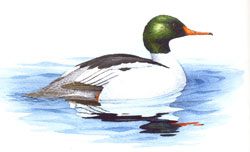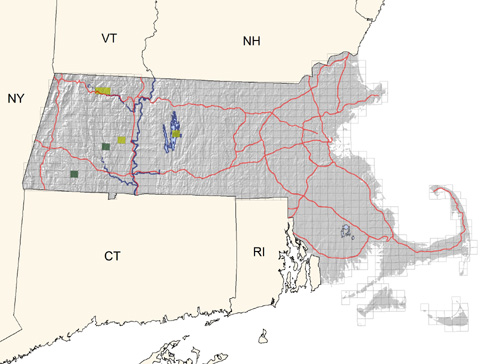Breeding Bird Atlases (BBA)
Find a Bird - BBA1
Breeding Bird Atlas 1 Species Accounts
Common Merganser
Mergus merganser
Egg Dates
late April to June
Number of Broods
one

Believed to have bred widely in the state before 1900, the Common Merganser then became casual or absent as a summer resident. A few pairs now breed locally at Quabbin Reservoir and along the larger swift-moving rivers in the western hill country. Migrant and wintering numbers have increased to common or abundant and have been fairly stable for the last 40 years. Common Mergansers frequent large lakes and ponds until they freeze over and then resort to open water rapids and the mouths of large rivers, or else they move farther south.
Inland peaks of up to 300 occur in March on large rivers as the birds begin moving north. The few that stay to breed seek out wild stretches of the Deerfield, Westfield, and Farmington rivers or large undisturbed bodies of water such as Quabbin Reservoir.
The call note, usually given when the birds are alarmed and about to flush, is a low, hoarse growl or croak. During courtship, soft guttural purrings are made, and the mating dance itself is energetic and elaborate. One or several drakes rush about, raise their salmon-tinted breasts or cock and spread their tails, kick water as they expose their bright red legs, and pursue and frequently strike rivals with their bills. There is much splashing and brief diving. When the drake is inactive, the female sometimes pursues him with head and neck held low in the water.
Nest sites are usually large holes in trees, in banks, or among rocks near or over water, occasionally in dense cover on the ground of small islands, or even in old hawk nests. By mid-May, the single clutch of eggs numbering six to seventeen (usually nine to twelve) is laid in a nest consisting wholly of down if sheltered in a cavity, or of assorted grasses and twigs lined with down and mixed with white feathers when located elsewhere.
After at least a month-long incubation, the young tumble out of the nest to the ground and accompany the female to feed in the shallows along the banks of ponds or in river pools. On June 22, 1978, a family with five small young was seen on the Westfield River in Huntington (Lynes), and on July 1 of the same year, five half-grown young were seen on the Farmington River in Sandisfield. There is a post-Atlas record of four full-grown young on July 26, 1987, on the Westfield River in Cummington (Gagnon). The males do not help in the incubation, and later in eclipse plumage they are found alone in the same habitats. The young reach flight stage in 60 to 70 days. In the early fall, the fully grown young, and perhaps both parents, visit other nearby bodies of water and may appear over a wide area.
The Common Merganser is primarily a fish eater, but insects and vegetation are also consumed. Minnows are the main prey, but this duck will capture any slow-moving warm-water fish. In fact, it plays an important role in controlling fish populations. On the coast, Blue Mussels may be eaten, shell and all. Common Mergansers do feed in brackish water but are seldom found on the open sea or in pure salt water. They are powerful divers and underwater swimmers, using both feet and wings to propel themselves in pursuit of food. As with most birds that swim well, when taking off from the water they must patter along the surface for a good distance before they can rise clear into the air.
In migration Common Mergansers fly high and swiftly in small wedge-shaped flocks, usually at night, although single birds are also seen flying high during the day. Only severe cold to our north drives these hardy birds to fresh waters in November and December, when numbers in coastal ponds build to migratory peaks that reach 1,000 in Plymouth County and Cape Cod, and 200 to 300 farther north on rivers around Boston and Newburyport. Numbers on the coast seem to decline as the season progresses, and only a few lingerers are found into the late winter.
Map Legend and Data Summary
Atlas 1 data collected from 1975-1979


Note: rare and local along major rivers in western portion of state; also at Quabbin Reservoir
Seth Kellogg



